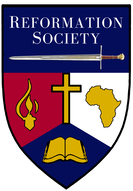
To view the screen capture video of this presentation, click here
To listen to the audio of the presentation, click here Reformation in Scotland As the books of Martin Luther and Tyndale's translation of the New Testament entered Scotland, they were received with great interest. Students at St. Andrews University began to take their faith seriously. Patrick Hamilton, a student at St. Andrews, wrote a book that was condemned as heretical. He fled to Germany, met with Luther and soon returned to Scotland. Hamilton began preaching the Protestant Faith with great boldness. The Betrayal of Patrick Hamilton By an act of Parliament, 17 July 1525, the importation of Luther's books into Scotland was prohibited. In 1528, the Archbishop of St. Andrews summoned Hamilton for "a debate." However, he had no intention of debating Hamilton; it was a trap. Before any of his friends could come to Hamilton’s defence, a church court hurriedly found him guilty of "heresy". Martyrdom While most heresy trials took weeks, Hamilton's was rushed through in less than 12 hours. It took 6 long, excruciatingly painful hours for Hamilton to die by burning at the stake. Patrick Hamilton was Scotland's first Protestant martyr. He was just 24 years old. His death inspired widespread interest in the Reformation, and an intensified opposition to Catholicism. Hamilton's last words were: "How long, O Lord shall darkness cover this realm? How long will you suffer this tyranny of men? Lord Jesus, receive my spirit!" 
Conversion
In 1543, the Regent for the infant Mary Queen of Scots initiated a pro-English, and pro-Protestant, policy. The Regent encouraged Bible reading and promoted preaching by Reformers. It was through the preaching of Thomas Guilliame, a converted friar, that John Knox was converted in 1543. The exhilarating effect of this newfound faith and freedom, the joy of experiencing God's grace in Christ, transformed Knox forever. Soon, however, the Scottish authorities reversed their initially pro-Reformation policies and began to threaten Protestants. The Courage of Wishart Tall, handsome and well-mannered George Wishart became the spokesman for Scotland's growing Protestant movement. Wishart travelled throughout the country proclaiming Reformation doctrines with skill and conviction. 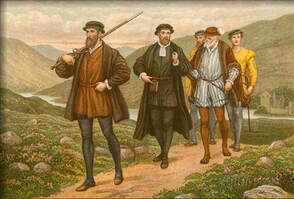
Persecution
Cardinal David Beaton, Archbishop of St. Andrews, had 5 Protestants executed in 1544 and twice tried to have the popular Wishart murdered. After one failed attempt on his life, out of concern for his safety, the Protestants organised for Wishart to move his location daily to avoid capture. John Knox, armed with a large double-handed, broadsword was part of the bodyguard appointed to travel with Wishart. Those who came to a service by George Wishart found, instead of the normal mass in Latin, congregational singing and a fiery, hour-long sermon in their own tongue. Sacrifice In 1536, believing his arrest imminent and unavoidable, Wishart dismissed his bodyguard saying, "one is sufficient for a sacrifice." Wishart was condemned as a heretic, strangled and burned by order of Cardinal Beaton. As the fire was lit, Wishart declared: "This flame hath scorched my body, yet hath it not daunted my spirit. But he who from yonder high place beholdest us with such pride, shall, within a few days, lie in the same as ignominiously as now he is seen proudly to rest himself." 
Revenge
Within 2 months of the execution of Wishart, 16 Scottish nobles assassinated Beaton in a most brutal way. Before being struck down Beaton was admonished: "Repent thee of thy former wicked life, but especially of the shedding of the blood of that notable instrument of God, Master George Wishart, which… cries for vengeance… We from God are sent to avenge it… Thou hast been, and remain an obstinate enemy against Jesus Christ and His holy Evangel." St. Andrews Then a group of ardent Protestants, the Castilians, took over the city of St. Andrews and garrisoned themselves in the castle there. Although Knox was not part of either the assassination, or this conspiracy, he decided to join the men to minister to them. Impressed by Knox's teaching abilities, they asked him to become the castle’s chaplain. (Although, Knox had studied Law and Theology at the University of St. Andrews and had been ordained, because of the excess of priests in Scotland, he had ended up becoming a tutor and had not previously served as a parish priest.) Knox was overwhelmed, reduced to tears and declined the offer, not feeling worthy. Called Over the next few days, the congregation persisted in extending to him the call. Then, while attending a local church service in St. Andrews, Knox heard Dean John Annand affirming Catholicism, claiming that it was "the Bride of Christ". Knox stood up in his pew and interrupted him, declaring that the Roman Church was no bride of Christ, but a prostitute. The Roman papacy had degenerated further from the Faith of the Apostles than the Jews had from Moses when they had crucified Christ. 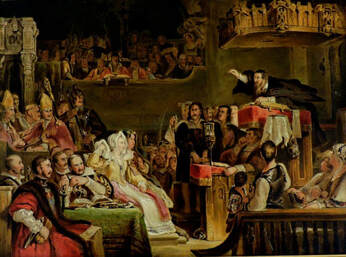
Striking at the Rotten Roots of Rome
At this, the congregation loudly demanded that Knox justify his remarks in a sermon the following Sunday - which he did. Knox declared that the Roman church had become the synagogue of Satan. He pulled no punches and one observer noted that while others snipped at the outer branches of the papacy, Knox "struck at the root to destroy the whole!" This was the beginning of the public career of one of the most powerful preachers of the Reformation era. Captured and Condemned The French fleet laid siege to St. Andrews Castle, which surrendered in July 1547. The rebels were taken to Rouen, in France. Knox and most of the Protestants were condemned for life to serve as galley slaves. A life sentence in the galleys was considered the next most severe punishment after execution. Knox said little about his time in the galleys, but two words that he used to described it was: "torment" and "affliction". During his time in the galleys, he contracted kidney infection and stomach ulcers, which afflicted him for the rest of his life. Galley Slave About 150 galley slaves, or forsairs, rode 6 to the oar. The 25 oars were each about 45 feet long. The rowers were kept chained to the oar, when not doing other duties. The comites on the ships carried whips to ensure that the convicts and prisoners of war pulled their weight. Galley slaves were considered a cheap and expendable form of fuel for ships. Knox was 33 years of age when he was condemned to the galleys. His strong character, which was evidenced throughout the rest his life and ministry served him well throughout this ordeal. 
Rejecting Idolatry
On one occasion, while mass was being celebrated on the galley, and the Salve Regina (O, Holy Queen) was sung, a statue of the Virgin Mary (Nostre Dame) was handed around for all on board to kiss. He refused: "Trouble me not; such an idol is accursed!" When this statue was again thrust before Knox’s face to kiss, he grasped it and threw the idol overboard declaring: "Now, let our lady save herself. She is light enough, let her learn to swim!" Steadfast Knox admitted that the prisoners on these galleys were "miserably treated". They were also placed under pressure to renounce Protestantism and embrace Catholicism. Knox was steadfast in rejecting all forms of Catholicism. Release and Freedom The English Protestant government of King Edward VI took a direct interest in the plight of these prisoners and in February 1549, after 18 months as a galley slave, Knox was released. This was probably at the direct intervention of King Edward VI, as part of a prisoner exchange. Knox the Puritan Knox spent the next 5 years in England as an honoured guest. He was granted preaching opportunities in Berwick and Newcastle. In 1551, Knox was appointed a royal Chaplain of King Edward VI. As Chaplain, he had the opportunity to preach before the king and contributed to the preparation of the second "Book of Common Prayer"(BCP). Knox, for example, insisted that the statement be included that "kneeling at the Lord's Supper does not imply any adoration of the bread and wine, nor is such adoration intended or permitted. On the contrary, it is stated explicitly, firstly that the natural body and blood of Christ are in Heaven, not on earth, and, secondly, that at the Lord's Supper both the bread and the wine stay the same as they are. To adore them is idolatry." When Knox was invited to become Bishop of Rochester, he declined. 
Bloody Mary and Exile
When King Edward VI died, 6 July 1553, the future of Protestants in England looked bleak. Mary Tudor made clear her intention to reinstate Catholicism as the national religion. Knox described Mary as the "wicked English Jezebel". Knox, along with thousands of other English Protestants, sought refuge in Protestant Germany and Switzerland. Switzerland Early in 1554, Knox travelled to Geneva, where he met John Calvin. Knox described Calvin's Geneva as "the most perfect school of Christ that ever was on earth since the days of the Apostles." Knox also met Heinrich Bullinger in Zürich. Frankfurt Knox settled in Frankfurt where a group of English and Scottish exiles asked Knox to be their pastor. This plunged Knox into distressing quarrels and controversies over what liturgy should be used. Knox had become critical of the "Book of Common Prayer" (BCP) and even about Calvin’s "Genevan Order of Service" (GOS), so he drew up a new Order of Service, which became known as the "Book of Common Order" (BCO). However, this was rejected by a large majority of the congregation. By March 1555, the congregation was split and the majority proposed Knox's dismissal. Some members of the congregation convinced the city authorities to prohibit Knox from preaching and to expel him from the city. It is interesting to note that although his "Book of Common Order" was rejected by the exiles in Frankfurt, in 1560 it became the official worship book of the Church of Scotland. The Lords of the Congregation While Knox was in exile in Europe, Protestant congregations were forming back in Edinburgh, Dundee, St. Andrews, Perth and Brechin. Most of these were clandestine meetings, and many used the English "Book of Common Prayer”. In December 1557, a group of Scottish nobles drew up a covenant to "set forward and establish the most blessed Word of God and His Congregation", to renounce Catholicism and to establish the Protestant Faith as the official religion of Scotland. This group became known as the "Lords of the Congregation". 
Geneva and Scotland
After being expelled from Frankfurt, Knox helped co-pastor an English congregation in Geneva. In August 1555 he returned to Scotland and spent 9 months preaching extensively throughout the land. The Catholic bishops summoned him to Edinburgh in May 1556 to face legal charges. Knox returned to Geneva where he assisted members of his congregation in a new translation of the Bible into English. This became known as the "Geneva Bible". When is it Right to Fight? Knox asked Calvin whether it was permissible to resist by force a monarch who was "idolatrous". Calvin maintained that individuals might refuse to obey commands contrary to God's Law, yet he could not accept revolt. However, Knox was coming to believe that Christians had the obligation to revolt against a tyrannical monarch. A ruler's highest obligation was to preserve pure faith and worship. In Knox’s "A Godly Letter" (1554) he taught that the nation could incur corporate guilt for tolerating evil. If the people permitted Catholicism to remain, the nation would be subjected to Divine judgment and plagues. God punished the entire tribe of Benjamin, for example, not because all were adulterers, but because some were tolerated. Idols for Destruction In his 1549 leaflet: "A Vindication That The Mass is Idolatry", Knox taught that idolatry entails not only worshipping what is not God, but also in trusting anything besides God. To honour anything in a religion contrary to God's Word is to lean on something other than God. That is idolatry. "The mass… is an abomination". The mass promoted a false atonement based on works. 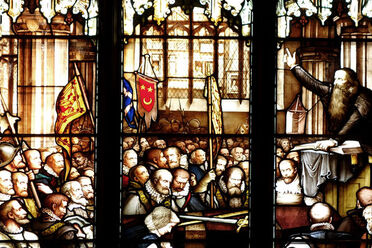
Rebellion Against God
Since the Law of God never changes, He would respond to sin in Scotland as He did in ancient Israel, e.g. raising up a Jehu to slay an idolatrous ruler. Knox demanded that God's Law be upheld in Scotland. If the people obeyed the unjust commandments of evil rulers, they would receive a far more terrible punishment from God than any ruler could inflict upon them for treason. Not to revolt against an idolatrous ruler was "plain rebellion against God". From Separation to Victory Knox maintained that, when in a minority, the faithful are only required to separate themselves from idolatry. However, when the believers are in a dominant position, and reasonably unified, they must not simply separate from idolatry, they must also abolish it. If exterminating idolatry meant overthrowing a tyrannical ruler, then that was necessary. Knox's sermons and writings on the subject were full of Scriptural examples: Abraham, Moses, Deborah, Samuel, Elisha, Hezekiah, Jehu, Elijah, Amos, Isaiah, Josiah, Jeremiah, and many other passages dealing with the Covenant, purifying national religion, resisting authorities who promoted idolatry, and the Sovereignty of God. "If princes exceed their bounds…there is no doubt that they may be resisted with power." The Minister of Justice Luther was protected by Prince Fredrick of Saxony, Zwingli by the mayor and council of Zürich, Calvin had the support of the Geneva City Council, the English Reformation at that time had King Edward VI. However, since no civil authority in Scotland was able to provide protection for Protestants, Knox believed that the abusive powers should be overthrown. In this Knox stands alone amongst the leading Reformers of the 16th Century. He openly challenged the standard interpretation of Romans 13, held by such Reformers as Luther, Zwingli, Tyndale and Calvin. 
A Call for Resistance
In his 1555 "Admonition to England", Knox condemned those leaders who had connived to restore the nation to Catholicism under Queen Mary Tudor. "Had she… been sent to hell before these days, then should not their iniquity and cruelty so manifestly have appeared to the world." In 1558, Knox published his most notorious "The First Blast of the Trumpet Against the Monstrous Regiment of Women" aimed directly at "Bloody Mary"- The Queen of England at that time. Knox stated that no woman could be a legitimate ruler - certainly not one who persecuted true Christians. "Bloody Mary" was a rebel against God, "a traitoress and rebel against God." Knox declared that it was against the Law of God and nature for such a woman to rule any kingdom because it subverted both the Divine and natural order. He called for the faithful to "remove from honour and authority that monster in nature." In his, "Appellations To the Nobility and Commonality of Scotland" he extended to the common people the right and duty to rebel against tyranny. Controversy John Calvin severely disapproved of Knox's First Blast and banned its circulation in Geneva. Within weeks of its publication, "Bloody Mary" died and the Protestant Queen Elizabeth ascended to the English throne. Many saw Knox's bold stand against the tyranny of "Bloody Mary" vindicated by her sudden removal and the accession of a Protestant Queen to the throne. However, most saw it as a monumental political mistake and distanced themselves from Knox. Knox admitted: "My First Blast has blown from me all my friends in England!" Queen Elizabeth I was appalled at Knox's tract. Knox's explanation that "the monstrous regiment of women" that he was referring to was "Bloody Mary" Tudor of England, Mary of Guise and Mary Queen of Scots, did not seem to repair the breach. Nor did Knox's public statement of support for the new Queen Elizabeth I as the Protestant Queen of England repair the damage of his once strong links to the Church of England. 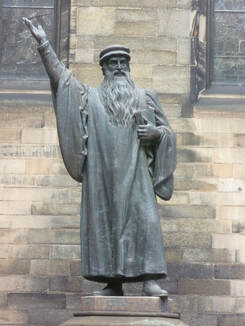
Reformation Sweeps Scotland
In May 1559, Knox arrived in Perth. His fiery sermon against Catholic idolatry was so effective that when the service was over, the congregation immediately began to demolish altars, smash images, statues, and crucifixes. They removed all the superstitious trappings of Romanism. Then the Lords of the Congregation militarily occupied Perth, Sterling, St. Andrews, and by the end of June, Edinburgh. There, Knox was elected minister at St. Giles Kirk in High Street. His Reformation preaching reverberated throughout Scotland. The French Outmanoeuvred To counter Mary of Guise and her French troops, the Scottish Lords of the Congregation drew up the Treaty of Berwick, February 1560, with the English. The Treaty was so effective that on 6 July 1560 the French and English both agreed to leave Scottish soil. Without French interference, the future of the Reformation in Scotland was assured! 
Thanksgiving and Confession
Later that month the Scottish Parliament met at St. Giles, in Edinburgh, for a great Thanksgiving service where Knox preached to them. The Parliament then ordered Knox and 5 of his colleagues to write a confession of faith. Hurriedly put to paper in 4 days, The Scots Confession is vibrant and spontaneous, filled with prophetic and militant language. It was adopted by Parliament, and remained, for 90 years, the Scottish churches’ official Theology. (In 1647, it was superseded by the Westminster Confession.) Faith in Action The Scots Confession stands out in how it specifies practical Christian ethics. It urges good citizenship, honourable living and a commitment to social justice in these words: "To have one God, to worship and honour Him, to call on Him in our troubles, to reverence His Holy Name, to hear His Word and believe it, to share in His Holy sacraments. "The second kind is: to honour father, mother, monarchs, rulers and superior powers; to love them, support them, obey their orders providing they are not contrary to God’s Commandments, save the lives of the innocent, overthrow tyranny, defend the oppressed, keep our bodies clean and holy, live in soberness and temperance, deal justly with all men in word and deed, and finally, to subdue any desire to harm our neighbour… Contrary acts are sins." (Article 14) A Higher Duty The Scots Confession not only permits the overthrowing of tyrants but makes such action mandatory. Tyrants are defined as the real rebels to the King of kings. Article 13 defines workers of iniquity as: "filthy persons, idolaters, drunkards and thieves… murderers, oppressors and cruel persecutors." The Scots Confession makes clear that no civil power is absolute. Civil leaders are permanently on probation and no Christian should give unqualified and absolute allegiance to any government. Christians must reserve the right of just rebellion against tyrants. Tough Times Demand Tenacious Faith No other Reformation Confession ventured so far into such dangerous waters, providing theological justification for rebellion against tyrants. As Knox declared: "Dangerous times demand vigorous faith." National Reformation On August 17, Parliament abolished the mass, repudiated papal jurisdiction over Scotland, and rescinded all laws at variance with the Reformed Faith. Comprehensive Reform Also in 1560, Knox's Treatise on Predestination was published in Geneva. The Geneva Bible was also published. This was the work of the English congregation that Knox had pastored. In December 1560 the "First Book of Discipline" drawn up by Knox and his colleagues was submitted to the General Assembly. Knox laid out plans for the comprehensive application of the Gospel to every area of Scottish life. He wanted a school in every parish, a college in every town, a university in every city, and regular, organised provision for the poor. Also in 1560, Knox's wife, Marjory, died. Mary Queen of Scots Although the Reformation Parliament of 1560 had worked with John Knox to mandate a Calvinist Scotland, the return of the Catholic Mary Queen of Scots in 1561 put that in jeopardy. As Queen, she refused to assent to the new order and Scotland remained officially Catholic. Mary Stuart was heir to England’s throne if Elizabeth died. With her strong ties to Philip II in Spain and the Guises in France, the Catholic threat to Scotland's emerging Reformation was serious. 
The Papist Threat
The Scots were well aware that in the Netherlands Protestants were being tortured, beheaded, hanged, drowned, burned and buried alive by the Vatican's heavy hand. They had recently witnessed the wave of horrible executions under "Bloody Mary" in neighbouring England. As rumours circulated that Mary Stuart would marry Don Carlos, the son of Philip II of Spain (the arch persecutor of Protestants), Knox preached a withering sermon declaring that: "all papists are infidels!" A Clear and Present Danger Philip II was well aware that Mary Stuart was the Vatican's best hope of restoring Catholicism to England: "She is the one gate through which religion can be restored in England. All the rest are closed." Immorality and Intrigue Mary Stuart married Lord Darnley of England, hoping to unite the Catholics of England and Scotland. When the Queen became pregnant, her young husband accused the Queen of adultery with her private secretary, David Rizzio. Lord Darnley (now King Henry) participated in the murder of Rizzio, 9 March 1556. On 15 June 1556, Mary Stuart delivered a son: James Charles Stuart (who grew up to become James I of England). Murdering Her Husband In revenge for voicing his suspicions, Mary Stuart arranged through her boyfriend, the Earl of Bothwell, the assassination of her husband, King Henry (Lord Darnley). Mary coaxed Henry back to Edinburgh, lulled his suspicions and arranged for him to be blown up by explosives. Both Protestants and Catholics in Scotland were outraged. Mary had Bothwell stand a mock trial, at which he was acquitted, then gave him Dunbar Castle and various lands to his associates. Confronting the Queen Knox was called before the Queen's Council - where he voiced his suspicions. Then he confronted Bothwell with charges of adultery, complicity in murder, and rape. When Bothwell married Queen Mary, May 1567, the nation became convinced that she had helped murder her husband. There were widespread calls for her to be deposed and the people turned against her. Knox demanded that the Queen stand trial for murder and adultery - both capital crimes. Mary Stuart was forced to abdicate and the nobles organised a swift coronation of the infant, James VI of Scotland (later he would become James I of England and of the United Kingdom). 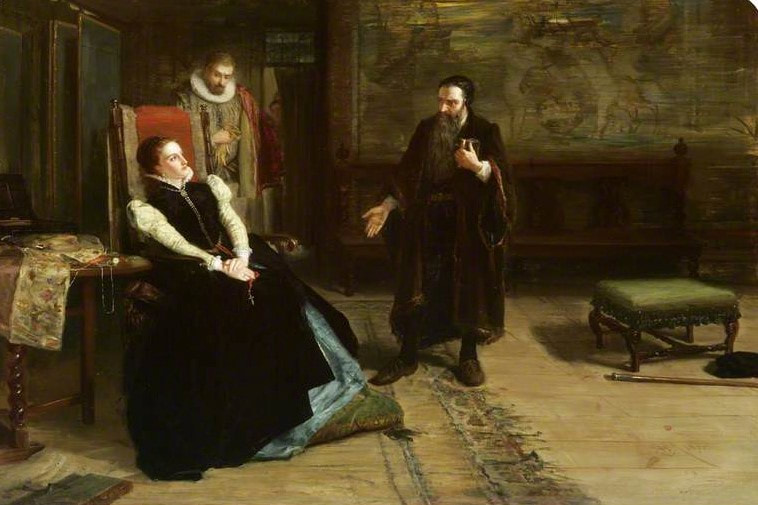
The Reformation Triumphs in Scotland
At this coronation, Knox preached from the pulpit about the baby Joash who was anointed and crowned while Queen Athaliah cried "treason" from her palace! The sermon included details from the Bible as to how the nobles had gone from the coronation of Joash to kill Athaliah, to tear down the temples of Baal and to restore the rule of the prophets in the land. While Knox was calling for the trial of Mary Stuart, she escaped and raised an army of 6,000 Catholics. However, when her army was confronted by the disciplined Protestants, Mary's army melted. She fled to England and sought the protection of her cousin, Elizabeth. Bothwell fled to Denmark. James Stuart James Stuart, Mary's half-brother, became Regent of Scotland. James Stuart (1531-1570) had been an influential figure in Scottish politics. By age 19, he was already a member of the Privy Council. He became Mary Queen of Scots' Chief Advisor when she returned to Scotland. However, as he was won over to the Protestant Faith and became a member of the Lords of the Congregation, he used his power to maintain and extend the influence of Protestantism. When Mary was forced to abdicate in 1567, and her infant son, James VI was crowned, Stuart was appointed Regent. He was described as: "a Puritan with natural charm and diplomacy".
Oppression and Insurrection At the same time, Europe was boiling. The Spanish Duke of Alva had fallen upon the Calvinist rebels of Holland with fire and sword. 8,000 Dutch Protestants were executed. Another 30,000 had their property confiscated. Then in 1568, the Inquisition condemned all 3 million Dutch Protestants to death as "heretics!" The Dutch valiantly resisted and declared independence. Philip II was facing a great revolt. Along with the war in the Netherlands, and civil war in France, a papal bull excommunicating Elizabeth inspired a Catholic uprising under the Earls of Northumberland and Westmoreland. The Catholic armies of Northumberland destroyed Bibles and prayer books, re-instituted the mass in Durham Cathedral, and moved to rescue Mary Stuart to make her Queen of England. Removing the Threat Elizabeth's army crushed the Catholic rebellion, and after numerous other intrigues and conspiracies to assassinate her and place Mary on the English throne were exposed, Elizabeth reluctantly agreed to Mary’s trial and execution. 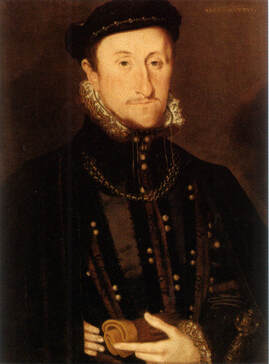
Assassination
The assassination in February 1570 of the Protestant Regent of Scotland, James Stuart, plunged Scotland into civil war. Later that year, Knox suffered a stroke. But he continued to preach throughout the last months of his life. Even as his health was deteriorating, he insisted on being carried to the pulpit. Success Before he died, in 1572, Knox had the joy of seeing the Reforms of 1560 ratified by the Scottish Parliament. Papal authority in Scotland was outlawed. All future rulers of Scotland were to swear to uphold the Reformed doctrine. The day before he died Knox said: "I have been fighting against satan, who is ever ready for the assault; I have fought against spiritual wickedness and have prevailed." The dedicated labours of John Knox resulted in Scotland becoming the most Calvinist nation in the world. The Verdict of History Otto Scott in "The Great Christian Revolution" summarizes his achievements: "Knox had humbled a reigning monarch, toppled a government, ousted a hierarchy, converted the people and could regard, towards the close of his life, the landscape transformed by his efforts and the teaching of his mentor, Calvin. Knox's triumph in Scotland…severed a tentacle of France and lessened the threat to the Reformation of England." 
Fearless
At his grave, one man declared: "Here lies a man who neither flattered, nor feared, any flesh." Dynamic One of Knox's followers had declared that his preaching was "able in one hour to put more life in us than 500 trumpets continually blustering in our ears." Stalwart The 19th Century historian, Thomas Carlyle, describes Knox as: "a most surprising individual to have kindled all of Scotland, within a few years, almost within a few months, into perhaps the noblest flame of sacred human zeal and brave determination, to believe only what it found completely believable, and to defy the whole world and the devil at its back, in an unsubduable defense of the same." To Carlyle, Knox was the very epitome of stalwart leadership, "the most Scottish of Scots… nothing hypocritical, foolish and untrue can find harbour in this man… fearing God and without any other fear." Uncompromising Douglas Wilson in his biography of Knox "For Kirk and Covenant" describes Knox as: "like Daniel in the Old Testament, he was forthright in his condemnation of sin, unguarded in his pronouncement of truth, and single-minded in his adherence to the Word of God. Like King Josiah, in ancient Israel, he did what was right in the sight of the Lord, never turning aside to the right hand or to the left. Like the great general Joshua, he dutifully obeyed the clear commands of Scripture, always steadfast and unwavering. But such character traits and such stands, however compelling, are inevitably costly. It nearly cost Knox everything during his lifetime and it has earned him the odium and ire of virtually every secular historian in the years since… a simple compromise here or there might well have saved him from imprisonment, exile and anathema. But he refused to compromise. He could have tried to work within the system. He could have tried conciliation, accommodation, or negotiation. But he refused to compromise, risking everything for the sake of principle."
God's Firebrand John Calvin described Knox as: "God's firebrand" and as a "brother…labouring energetically for the faith." Mary Stuart, Queen of Scots, had been heard to declare, trembling and in tears: "I am more afraid of the prayers of John Knox than of an army of 10,000." John Knox’s famous prayer: "Give me Scotland or I die!" was thoroughly answered in his lifetime. "I have fought the good fight, I have finished the race, I have kept the faith." 2 Timothy 4:7 Frontline Fellowship P.O. Box 74 Newlands 7725 Cape Town South Africa Tel: 021-689-4480 Email: [email protected] Website: www.frontlinemissionsa.org 
This article is adapted from a chapter of The Greatest Century of Reformation, by Dr. Peter Hammond. It is available from
Christian Liberty Books, PO Box 358, Howard Place 7450, Cape Town, South Africa, tel: 021-689-7478, email: [email protected] and website: www.christianlibertybooks.co.za.
3 Comments
Morris Hulley
12/5/2023 08:43:51 am
Under the heading "Persecuted" it is indicated that John Knox in 1544 occupied the position of one of the "body guards" of George Wishart.
Reply
Morris Hulley
12/5/2023 08:12:18 am
Thanks for the lesson - giving the efforts of John Knox, living in Scotland now is a deeply disappointing experience.
Reply
Leave a Reply. |
History ArticlesCategories
All
Archives
May 2023
|
- Home
-
History Articles
- History Articles
- All Categories
- Character Studies
- Greatest Century of Missions
- Greatest Century of Reformation
- Reformation In Bohemia
- Reformation In England
- Reformation In France
- Reformation In Geneva
- Reformation In Germany
- Reformation In Italy
- Reformation In Scotland
- Reformation in Switzerland
- Victorious Christians
- Contemporary Articles
- Resources
- Contact
- Donate
|
The Reformation Society
PO Box 74, Newlands, 7725, South Africa Tel : (021) 689-4480 Email: [email protected] Copyright © 2022 ReformationSA.org. All rights reserved |
- Home
-
History Articles
- History Articles
- All Categories
- Character Studies
- Greatest Century of Missions
- Greatest Century of Reformation
- Reformation In Bohemia
- Reformation In England
- Reformation In France
- Reformation In Geneva
- Reformation In Germany
- Reformation In Italy
- Reformation In Scotland
- Reformation in Switzerland
- Victorious Christians
- Contemporary Articles
- Resources
- Contact
- Donate


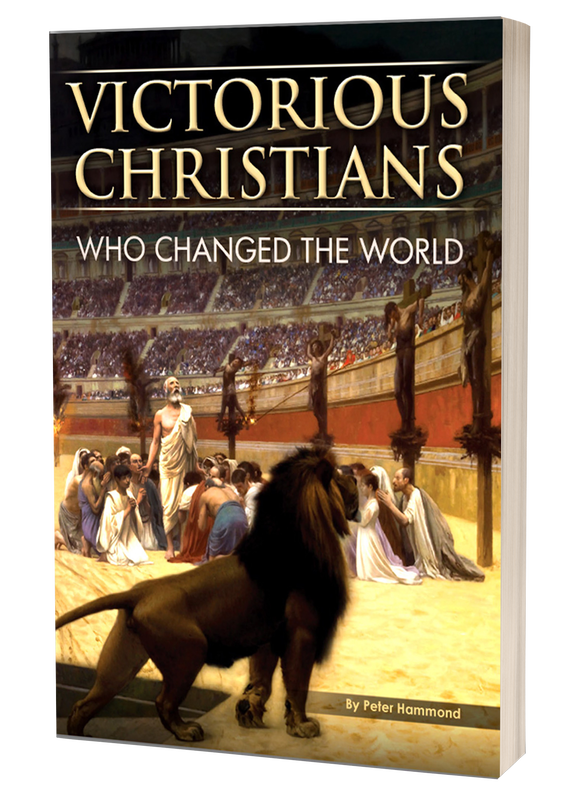
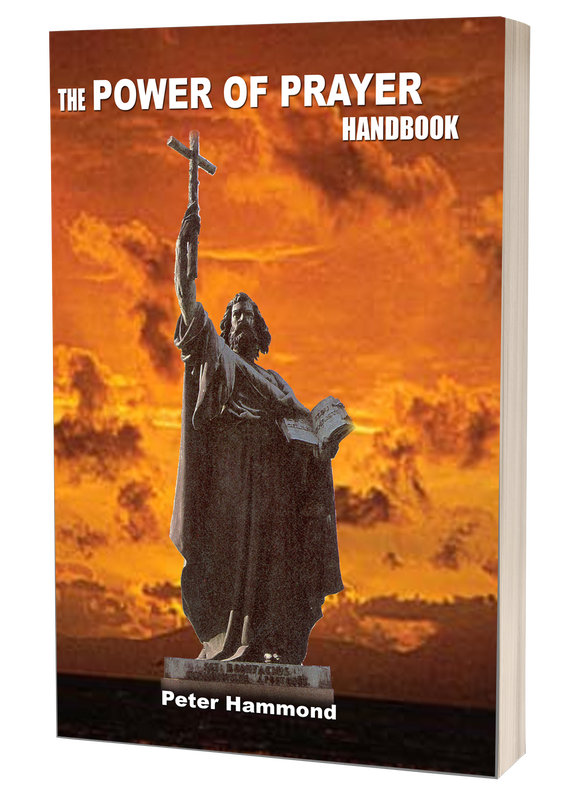
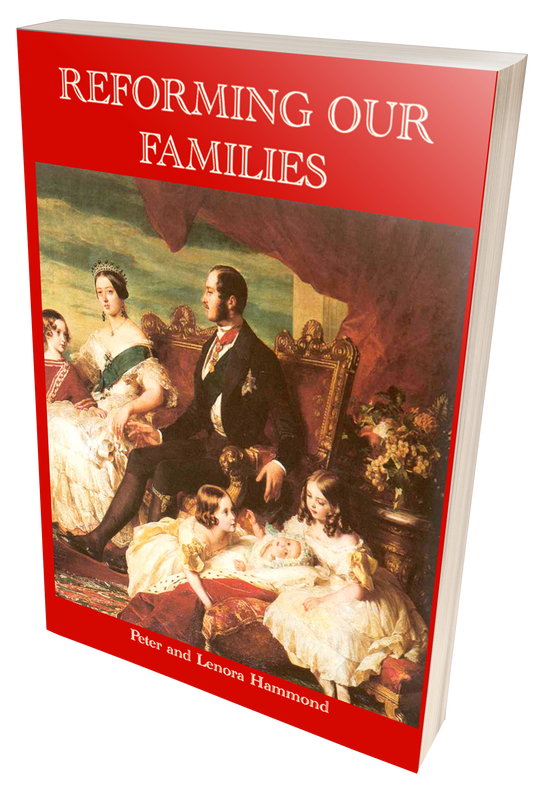
 RSS Feed
RSS Feed
